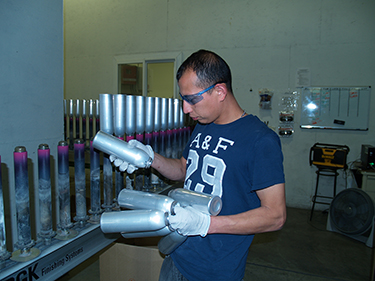|
Subscribe / Renew |
|
|
Contact Us |
|
| ► Subscribe to our Free Weekly Newsletter | |
| home | Welcome, sign in or click here to subscribe. | login |
Environment
| |
 |
September 25, 2014
Tackling toxics with green chemistry
Department of Ecology

Zarker
|
In the Pacific Northwest, we’ve grown accustomed to thinking about the environmental impact of our everyday lives: We buy products made with natural ingredients, we work in sustainable buildings, and we light and heat those buildings with renewable energy.
Despite that commitment, toxic chemicals continue to impact the health of our families and the environment of our region. Copper reduces salmon survival rates, PCBs build up in orca whales, and phthalate plasticizers may affect our children’s development.
Every problem creates an opportunity, though, and finding safer alternatives to toxic chemicals is an area where opportunities abound. This emerging field is called green chemistry. It’s the science of building safer products and designing cleaner manufacturing methods. And it’s an area where the Pacific Northwest is leading the way.
Leadership leads to change
Chemistry sounds like something that only happens in a lab, but finding safer chemicals often requires leadership from across an organization. Many of the people driving this change work in purchasing, supply chain management, occupational health, or sustainability. They may be entrepreneurs chasing an opportunity or CEOs seeking an edge. Wherever they come from, these are leaders who are willing to challenge the status quo and make a break from the way things have traditionally been done.
Consider the Bullitt Center in Seattle. Designed to the exacting specifications of the Living Building Challenge, the Bullitt Center was built to be the greenest commercial building in the world. Part of meeting that lofty standard required the builders to steer clear of a red list of toxic chemicals. That created a dilemma for the architects when they discovered that the breathable building membrane they specified contained phthalates, one of the red list chemicals.
Phthalates are a common chemical used to make plastics flexible, but they have been linked to reproductive and developmental concerns. Washington state banned the use of phthalates in children’s products in 2009.
Fortunately for the Bullitt Center, the membrane’s manufacturer was able to reformulate its product to meet the same performance standard with a safer chemical. What’s more, the manufacturer decided to switch its entire product line to the phthalate-free alternative.
You can find another example across the mountains near Yakima where Liberty Bottleworks manufactures sports bottles using recycled aluminum in a zero-waste plant.
Liberty wanted to find an alternative to the plastic coating containing bisphenol A, or BPA, which was often used to coat the interior of metal drinking bottles. There are concerns about BPA’s potential effects on infants and children, and Washington state banned the chemical’s use in children’s drinking products in 2011 and in sports bottles in 2012.
After some searching, Liberty found a powder coating that uses food-grade polyester. Consumers seem to appreciate Liberty’s commitment to making a safer product — since production began in 2011, the company has sold more than a million bottles.
Both Liberty and Bullitt demonstrate the impact a company can have by pushing their suppliers to find safer alternatives. Already, many of our region’s leading companies are working with their suppliers to identify hazardous chemicals in their products and seek out safer alternatives.
Some companies are working together to address common concerns. Members of the Outdoor Industry Association, for instance, have cooperated to create a chemicals management framework, which gives member companies a guide to discuss chemical hazards with their global suppliers.
More resources coming
Educational and nonprofit organizations are also stepping up. Northwest Green Chemistry is a new nonprofit established to facilitate research, development, commercialization, technical assistance, and education in green chemistry and engineering. Northwest Green Chemistry is holding a roundtable Oct. 28 in Tacoma to share the latest opportunities, innovation and research in the field.
The University of Washington’s Professional and Continuing Education department will offer a certificate program in green chemistry in 2015, giving professionals the opportunity to study the principles of green chemistry and then apply them in their workplaces.
The Washington Department of Ecology developed an alternatives assessment guide in cooperation with a group of other states, and offers free training in assessing chemical hazards. Toxics reduction specialists with Ecology work with many of the state’s manufacturers on reducing their use of hazardous chemicals and finding safer substitutes.
None of this is to suggest that there are easy answers to the chemical hazards we face in Washington. But it does show that there are solutions out there and increasing numbers of people dedicated to solving those problems.
Ken Zarker is section manager for pollution prevention and regulatory assistance at the Washington Department of Ecology, chairman of the board for the National Pollution Prevention Roundtable, and acting director for Northwest Green Chemistry.
Other Stories:
- Passive House finds a permanent home in the Northwest
- Survey: Landau Associates
- Survey: HWA GeoSciences
- Survey: Eco Chemical
- Survey: Environmental Resources Management
- Survey: WISErg Corp.
- Survey: Environmental Sciences Associates
- Survey: Farallon Consulting
- These modular classrooms are not old school
- Local firms invent modules to protect Louisiana coast
- Old mining pond becomes new salmon habitat
- Time to jump on contaminated urban properties?
- How biosolids can curb greenhouse gases
- Lower Duwamish: watershed management poster child?
- Is hard water drowning Eastern Washington’s economy?
- Preserving Seattle’s largest forest takes a group effort
- Being green is not just about checking boxes
- Carbon-rich tidal wetlands down, but not out
- Survey: Herrera Environmental Consultants



